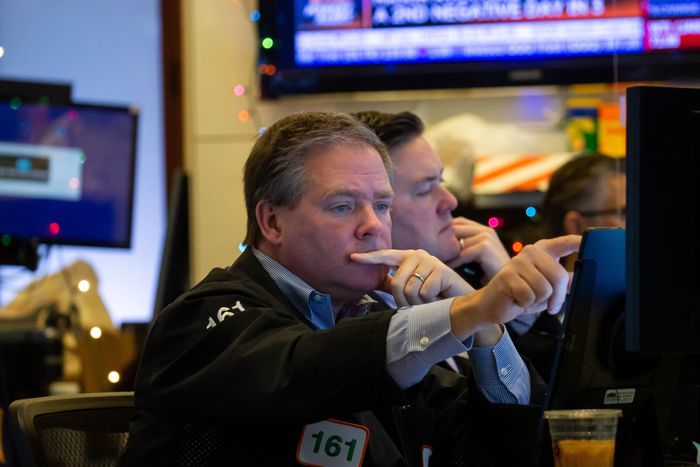U.S. stocks rose after Federal Reserve officials approved plans to more quickly wind down pandemic stimulus efforts, giving investors more insight into the central bank’s response to high inflation.
All three major indexes turned higher after the afternoon release of a much-awaited Fed statement, published at the end of a two-day policy meeting, and continued to climb as Chairman Jerome Powell spoke at a news conference. Fed officials voted to hold rates near zero Wednesday but most signaled they were ready to lift their short-term benchmark rate at least three times next year.
Stocks had pulled back this week as investors awaited the update from the central bank. Some investors said that uncertainty about the Fed’s next moves, rather than unhappiness with the potential changes in monetary policy, may have weighed on stocks in recent sessions.
The market’s reaction to the Federal Reserve’s statement was “almost like a sigh of relief,” said Anu Gaggar, global investment strategist at Commonwealth Financial Network. “It’s like that uncertainty has been lifted.”
The S&P 500 gained 75.76 points, or 1.6%, to 4709.85, closing less than 0.1% away from a record. Ten of the U.S. stock benchmark’s 11 sectors rose, while the energy group declined. The Dow Jones Industrial Average rose 383.25 points, or 1.1%, to 35927.43. The Nasdaq Composite climbed 327.94 points, or 2.2%, to 15565.58.
Accommodative monetary policy has helped propel U.S. indexes to dozens of records since the arrival of the coronavirus pandemic sent stocks swooning in early 2020. Low interest rates have made it easy for companies to borrow and pushed investors toward stocks.
But surging consumer prices have intensified the focus by Fed officials on curbing inflation, raising questions among investors about how quickly the central bank would pare back its asset purchases and lift its short-term benchmark rate. U.S. inflation hit a 39-year high in November and producer prices also jumped.
“What’s really coming in context is that inflation is hotter for longer than expected and the Fed is acknowledging it,” said Esty Dwek, chief investment officer at FlowBank, before the Fed’s afternoon announcement. “There’s also the view that new variants are not just a concern for growth, but a concern for inflation.”
Oil prices ticked higher after the Fed statement, with global benchmark Brent crude adding 0.2%. The International Energy Agency said Tuesday it had reduced its forecast for 2022 energy demand, citing the Omicron variant of the coronavirus, and cut its supply outlook.
The emergence of the Omicron variant has injected fresh volatility into markets in recent weeks as investors question whether their previous expectations for the economy still hold. The first large real-world study showed that the efficacy of two Pfizer shots declined against the strain, both for infection and hospitalization. The variant accounts for about 3% of cases in the U.S.
“Our view is that Omicron passes,” said Alex Chaloff, co-head of investment strategies at Bernstein Private Wealth Management. “It’s more worrisome that there continues to be these mutations and new strains.”
In new economic data, retail sales rose by a seasonally-adjusted 0.3% in November, slowing from October’s pace. Economists had predicted an 0.8% increase amid the holiday shopping season.
U.S. government bond yields rose, with the yield on the benchmark 10-year U.S. Treasury note climbing to 1.460% Wednesday from 1.437% Tuesday. Yields rise as bond prices fall.

Investors are watching to see if Omicron will change how quickly the Fed ends easy-money policies.
Photo: Michael Nagle/Bloomberg News
Among individual stocks, Eli Lilly shares climbed $25.90, or 10%, to $275.28 after the pharmaceutical company raised its full-year guidance. Shares of chemical company Albemarle fell $4.04, or 1.7%, to $239.79 after Goldman Sachs cut its rating on the stock.
Bitcoin climbed along with stocks. It traded at about $49,221 at 5 p.m. Eastern on Wednesday, up 1.9% from 24 hours earlier, according to CoinDesk.
Overseas, the pan-continental Stoxx Europe 600 added 0.3%. In Asia, most major benchmarks closed down. The Shanghai Composite Index retreated 0.4%, while Hong Kong’s Hang Seng Index lost 0.9%. Data showed China’s economic activity slowed in November, driven by a property slump and sluggish consumer spending.
Write to Karen Langley at [email protected] and Anna Hirtenstein at [email protected]
Copyright ©2021 Dow Jones & Company, Inc. All Rights Reserved. 87990cbe856818d5eddac44c7b1cdeb8








